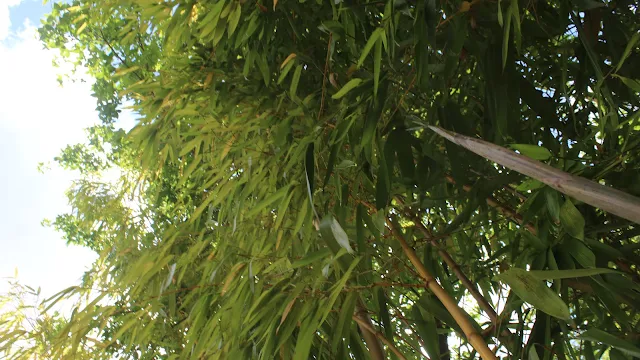They are common in the temperate and tropical zones mainly in Asia, Central and South America and the Pacific region.
The bamboo’s woody stems grow fast.
Like the other grass species, bamboos have hollow stems, and slender (bladed) leaves that form formidable evergreen foliage.
Parts of a bamboo plant
This outline will help you to identify the 10 common parts of a bamboo plant.In fact, knowing the different parts is important for understanding your bamboo plant.
Let’s take a quick look at these parts starting from the ground up.
Rhizomes
Bamboo rhizomes are common in both running and clumping bamboos.In the running bamboos, the rhizomes are also known as the horizontal underground stems. As the name implies, the rhizomes run along the ground and spread aggressively.
In the clumping bamboos, the rhizomes tend to keep close together and form tight bases or clumps, hence the name clumping bamboos.
The rhizomes are the ‘engine rooms’ where a bamboo plant derives its ‘power’ and ‘energy’ for growth and development.
Bamboo Roots
Bamboo roots are not rhizomes.The roots, feeding roots or root hairs, are the thin underground tendrils that grow into the soil, usually from the rhizome nodes.
The roots are vital for nutrient and water uptake and for supporting the whole bamboo plant.
Bamboo Leaves
Bamboo leaf and foliage are often used interchangeably to mean the same thing, however, there is a slight difference.A leaf is the single green vegetative part of the bamboo that appears on the branch, whereas foliage refers to a cluster of leaves.
Bamboo growers say, ‘there are lots of green leaves on the bamboo’ or alternatively they say ‘this evergreen foliage is pretty'. That latter sounds right, hey!Either way, the bamboo leaves create notable evergreen foliage that appears all year round.
Of course, the leaves are also vitally significant for photosynthesis and transpiration in bamboo plants.
Bamboo Culms
Bamboo culms are often referred to as bamboo stems or canes.The culms start off from the ground as tender shoots.
The culms are cylindrical and have nodes between two internodes.
Bamboo culms are usually hollow with different thicknesses.
The lower parts of the bamboo culms are the culm base and culm petiole which are found either underneath the ground or just above it.
Parts of a running bamboo
The running bamboos have noticeably long-running rhizomes with pointy tips, also called the Leptomorph rhizomes and can grow over a considerable distance.Parts of a clump-forming bamboo
The rhizomes of the clumping bamboos are stout, and thick and grow upwards from the parent plants, also called the Pachymorphs rhizomes.Usually, the base culms are much thicker than the stem, compact as they grow upward, forming solid tight clumps.
 Dia: Adapted from Bamboos by C.Recht & M.F. Wetterwald
Dia: Adapted from Bamboos by C.Recht & M.F. Wetterwald
Importance of knowing the parts of a bamboo
As mentioned earlier, there are many different groups of bamboo cultivars.The common bamboos we know in the UK are the clump-forming and running bamboos.
The running and clumping bamboo plants have different parts which are important when it comes to identifying them.
This is vital especially when reading material or working with bamboo.
We hope that this information gives you some ideas about the parts of a bamboo plant.
Bamboo Grow and Care
We have a lot of useful materials as well as bamboo features that you may find useful.Check out the main menu, or related articles below for more information.
If you are looking for info on a specific bamboo, why not leave a comment below?
We may be able to help. Or alternatively, we will refer you to the right place where you can get the right help.


No comments:
Post a Comment
Thank you for the comment.